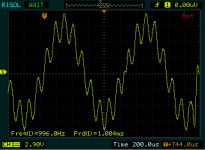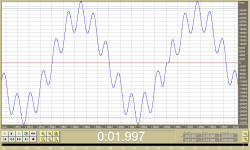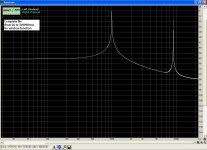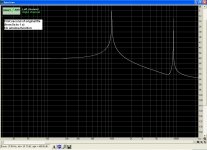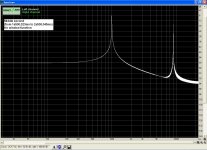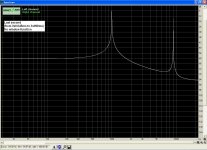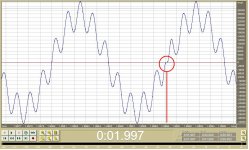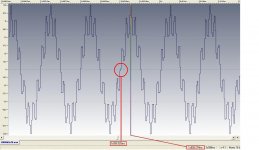The time difference is approximately 1 sec. I cut out ca. 1 sec of the first 1.5 seconds and
approximately the same amount from the last part. I can put wav. directly in my FFT analyser. We both seem to be wave form addicted
What format can you read ? Maybe i could create something you can use.
approximately the same amount from the last part. I can put wav. directly in my FFT analyser. We both seem to be wave form addicted
What format can you read ? Maybe i could create something you can use.
OK what I did was down load the file from the thread, expand it and compare it to the original. It seems that with one software expander (the same I used to compress it generic with my 96 version of windows) there was no loss I found. With the other it resembles what George got!
So next week I will put my young apprentice on producing some more files and post them on my website.
Listening here I think I hear an increase in harshness after the tick. Brian here also hears a difference, Warren does not. The tick is a gap in the waveform at zero level where we switch between the phase shifts. If you plot it the 1K would still line up, but the 9k switches sides of the 1K.
Note that the bandwidth at the change exceeds 100K!
So next week I will put my young apprentice on producing some more files and post them on my website.
Listening here I think I hear an increase in harshness after the tick. Brian here also hears a difference, Warren does not. The tick is a gap in the waveform at zero level where we switch between the phase shifts. If you plot it the 1K would still line up, but the 9k switches sides of the 1K.
Note that the bandwidth at the change exceeds 100K!
In wav generated with 44.1kHz sampling?Note that the bandwidth at the change exceeds 100K!
(The same moment, captured with dig. scope and in sound editor)
Attachments
The time difference is approximately 1 sec. I cut out ca. 1 sec of the first 1.5 seconds and
approximately the same amount from the last part. I can put wav. directly in my FFT analyser. We both seem to be wave form addicted
What format can you read ? Maybe i could create something you can use.
Co-addicted Joachim
Thanks for the offer. I fixed the problem with RMAA 5. Now it works
I did a wave file with the 1st second, one with the last second and one around the middle.
I can not hear any difference in sound in these three files. Nix (par the click in the middle).
Attached are the FFTs from the original complete file and from it’s 3 parts of it.
I don’t see any much difference in there. The 9kHz peak is exactly 10dB below the 1kHz peak on all of them.
OK what I did was down load the file from the thread, expand it and compare it to the original. It seems that with one software expander (the same I used to compress it generic with my 96 version of windows) there was no loss I found. With the other it resembles what George got!
So next week I will put my young apprentice on producing some more files and post them on my website.
Listening here I think I hear an increase in harshness after the tick. Brian here also hears a difference, Warren does not. The tick is a gap in the waveform at zero level where we switch between the phase shifts. If you plot it the 1K would still line up, but the 9k switches sides of the 1K.
Note that the bandwidth at the change exceeds 100K!
It seems that with one software expander (the same I used to compress it generic with my 96 version of windows) there was no loss I found. With the other it resembles what George got! !
Trouble ahead. I don’t want to know
The tick is a gap in the waveform at zero level where we switch between the phase shifts.
Now you drive me crazy !

Can you please specify the exact location (from the start of the file in ms) of this bloody gap ?
Regards
George
Attachments
Can you please specify the exact location (from the start of the file in ms) of this bloody gap ?
Regards
George
George the previous post shows it. The click is because the reproducing software has inadequate bandwidth, but if the expansion software you used is not the same as mine it may eliminate it!
ES
In wav generated with 44.1kHz sampling?
(The same moment, captured with dig. scope and in sound editor)
BV beautiful you show the difference between -30 degrees and +30 perfectly!
I would think mono phase sensitivity shown to be derived from differences in IM distortion in the ear ref. Manfred Schroeder
This is based on an article by M. Schroeder.
George the previous post shows it. The click is because the reproducing software has inadequate bandwidth, but if the expansion software you used is not the same as mine it may eliminate it!
ES
Thank you Ed.
I hope you mean this (BV post):
http://www.diyaudio.com/forums/attachments/analog-line-level/236186d1313768164-john-curls-blowtorch-preamplifier-part-ii-wav1.png
Good then. It is at the place I had located the difference in pattern. http://www.diyaudio.com/forums/attachments/analog-line-level/236133d1313749778-john-curls-blowtorch-preamplifier-part-ii-click-4.jpg
But I really missed the cause of it (the “gap”). Sniff
Lesson learned (Mind the gap)
Regards
George
Attachments
Last edited:
Now I would have been impressed if folks had described the difference before it was shown and talked about. That might even have impressed SY.
Ed
I know you are referring to the difference of sound between the two halves of the file.
I’ve already confessed my deafness. I am out of this game.
But I would like to ask you about the “tick”. You wrote : “The click is because the reproducing software has inadequate bandwidth”
Have you heard it through a software without this bandwidth restriction? If yes, what’s the bandwidth and how it sounded (or it didn’t sounded at all?)?
I am afraid you are opening a can of worms with this. (the “gap” has a width of one digitisation step at 44.1kHz.) SY is gonna haunt you
Regards
George
I’ve already confessed my deafness. I am out of this game.
But I would like to ask you about the “tick”. You wrote : “The click is because the reproducing software has inadequate bandwidth”
Have you heard it through a software without this bandwidth restriction? If yes, what’s the bandwidth and how it sounded (or it didn’t sounded at all?)?
I am afraid you are opening a can of worms with this. (the “gap” has a width of one digitisation step at 44.1kHz.) SY is gonna haunt you
Regards
George
No you are in the game because your results are honest.
The basic trick in the days of tape was to use a small magnet to erase the signal when you made a splice so that you wouldn't hear it. It is my OPINION the reason you hear a click at 1 sample for 1 LSB is that the player has issues. After all you can hear that and not the larger difference in the waveforms.
It is my OPINION the reason you hear a click at 1 sample for 1 LSB is that the player has issues. After all you can hear that and not the larger difference in the waveforms.
Not only you didn’t answer my questions, you feed the fire with oil (the player has issues). I SY him coming.
By the way, the click is 1 sample wide but it is not only 1LSB high. It’s amplitude is 1% of the 1kHz (peak to peak) waveform.
Regards
George
Don't worry, I haven't had a chance to play the wav file on my home system. I would have fun (not) explaining to my wife why I'm listening to that annoying sound.
You can reply that it is a special sound clip for properly polarising the inner ear before a listening session
When you splice a tape you create a discontinuity that could not have possibly come from the signal chain.
Scott you make the point that the click from the tape spit as well as the click from the abrupt phase change on Ed’s file are unrelated to normal sound recording material, that’s why it is easy for the ear to pick them up.
That’s correct.
These abrupt changes don’t happen with real audio material , thus there is no point discussing them in length.
Ed didn’t intent to build a case with the click. He said it was an artefact .
It is me that made noise on this. But it is out of curiosity.
Regards
George
That is an excellent test signal, and most annoying too  . Although the details have been disclosed now I've tried to pick up as less as possible of that while downloading the signal and listening to it. All I heard is the centered click increasing to a very high 'pling' when pushed in level (partly a tweeter issue), and all I saw is a centered and mirrored phase shift of the HF tone, but I failed to see that nasty little glitch.
. Although the details have been disclosed now I've tried to pick up as less as possible of that while downloading the signal and listening to it. All I heard is the centered click increasing to a very high 'pling' when pushed in level (partly a tweeter issue), and all I saw is a centered and mirrored phase shift of the HF tone, but I failed to see that nasty little glitch.
- Klaus
As phase and absolute polarity issues where also in the discussion, here another test signal, gentler to the ear (listen at low/medium volume, but close to one speaker) :
- Klaus
As phase and absolute polarity issues where also in the discussion, here another test signal, gentler to the ear (listen at low/medium volume, but close to one speaker) :
Attachments
Last edited:
Don't worry, I haven't had a chance to play the wav file on my home system. I would have fun (not) explaining to my wife why I'm listening to that annoying sound.
But you already know the answer! It would have been impressive if someone had responded "About 1/2 way through there is an annoying change!"
- Status
- Not open for further replies.
- Home
- Member Areas
- The Lounge
- John Curl's Blowtorch preamplifier part II
